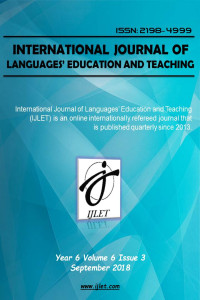The Predecessors of Foreign Resources that Raise Awareness on the Ottoman Language (Turkish Language) and Provide a Nationalist View on the Turks
Öz
The Ottoman Empire, in the course of the crisis that it experienced in the 19th century, became a government within a state that would not escape the attention of European states as a result of military innovations as well as investments made in the name of education, training and social transformations. Learning and teaching the Ottoman language, which was the dominant language of the Ottoman geography, has been the subject of many sources, depending on the fact that the European states are perceived primarily as a commercial market, but also due to the scientific enrichment of cultural life.These sources taken over the Ottoman language provide an opportunity to determine the morphologic examination of sentence structure and words in terms of scientific process and historical process of Turkish language more clearly. Up to these sources it was possible to follow the development of Turkish language through written sources. However, these sources also make it easier for us to see the position of the Turkish language, in other words, against other languages in the centuries, by taking the language directly under the spotlight. Teaching of these new works in educational institutions has provided the foundation for Turkish language to enter into a national process separately from Arabic and Persian languages over time. This new process has brought a simpler and more nationalist stance by removing Arabic and Persian for the Turkish language and rearranging the grammar rules. Accordingly, at the beginning of the 20th century, it emerged as a “National Literature” in case of necessity. Here we will try to touch on the resources that have been instrumental in starting this process, how we have pioneered the successive works on the writer's short biography and the contents that he took into account when writing the work.
Anahtar Kelimeler
Kaynakça
- Anderson, Benedict (2011). Hayali Cemaatler, İstanbul: Metis Yay.
- Beydilli, Kemal. (1995). Mühendishane, İstanbul, Eren Yayıncılık.
- Davids, Arthur Lumley. (1832). A grammar of the Turkish Language: with a preliminary discourse on the language and literature of the Turkish Nations, London. (Yay. Haz.:Erdem, Dursun.-Akkaya, Ahmet.- Bayrak, Özcan.- Yavuz, Serdar. (2013). Türk Dili Grameri, İstanbul: Nobel Akademik Yayıncılık).
- Dubeux, Luis. (1856). Éléments de la Grammaire Turque, Paris: p.VI
- Findley, Carter V. (1998). “Sir James W. Redhouse (1811-1892) Mükemmel Bir Doğu Bilimcinin Öyküsü”, çeviren: Nuray Şimşek, Kebikeç, 6/1998, s. 211-245.
- Heidegger, Martin. (2010).Düşünceye Çağıran Yurt Müdafaası (Çeviren Ahmet Aydoğan), İstanbul: Say Yayınları.
- Holderman, Rahip P. Jean Baptiste. (1730). Grammaire Turque ou Methode Courte & Facile pour Apprendre La Langue Turque, Constantinople.
- Kasımoğlu, Alper. (2013). Milliyetçilik ve Dil Milliyetçiliğinin Başarı ve Başarısız¬lıkları, Yalova: Yalova Sosyal Bilimler Dergisi, Issue: 5, p.161-173.
- Levend, Agâh Sırrı. (1972).Türk Dilinde Gelişme Ve Sadeleşme Evreleri (3nd edition), Ankara: Türk Dil Kurumu Yayınları.
The Predecessors of Foreign Resources that Raise Awareness on the Ottoman Language (Turkish Language) and Provide a Nationalist View on the Turks
Öz
Anahtar Kelimeler
Kaynakça
- Anderson, Benedict (2011). Hayali Cemaatler, İstanbul: Metis Yay.
- Beydilli, Kemal. (1995). Mühendishane, İstanbul, Eren Yayıncılık.
- Davids, Arthur Lumley. (1832). A grammar of the Turkish Language: with a preliminary discourse on the language and literature of the Turkish Nations, London. (Yay. Haz.:Erdem, Dursun.-Akkaya, Ahmet.- Bayrak, Özcan.- Yavuz, Serdar. (2013). Türk Dili Grameri, İstanbul: Nobel Akademik Yayıncılık).
- Dubeux, Luis. (1856). Éléments de la Grammaire Turque, Paris: p.VI
- Findley, Carter V. (1998). “Sir James W. Redhouse (1811-1892) Mükemmel Bir Doğu Bilimcinin Öyküsü”, çeviren: Nuray Şimşek, Kebikeç, 6/1998, s. 211-245.
- Heidegger, Martin. (2010).Düşünceye Çağıran Yurt Müdafaası (Çeviren Ahmet Aydoğan), İstanbul: Say Yayınları.
- Holderman, Rahip P. Jean Baptiste. (1730). Grammaire Turque ou Methode Courte & Facile pour Apprendre La Langue Turque, Constantinople.
- Kasımoğlu, Alper. (2013). Milliyetçilik ve Dil Milliyetçiliğinin Başarı ve Başarısız¬lıkları, Yalova: Yalova Sosyal Bilimler Dergisi, Issue: 5, p.161-173.
- Levend, Agâh Sırrı. (1972).Türk Dilinde Gelişme Ve Sadeleşme Evreleri (3nd edition), Ankara: Türk Dil Kurumu Yayınları.
Ayrıntılar
| Birincil Dil | İngilizce |
|---|---|
| Konular | Türk Dili ve Edebiyatı (Diğer) |
| Bölüm | Araştırma Makalesi |
| Yazarlar | |
| Yayımlanma Tarihi | 30 Eylül 2018 |
| Yayımlandığı Sayı | Yıl 2018 Cilt: 6 Sayı: 3 |


